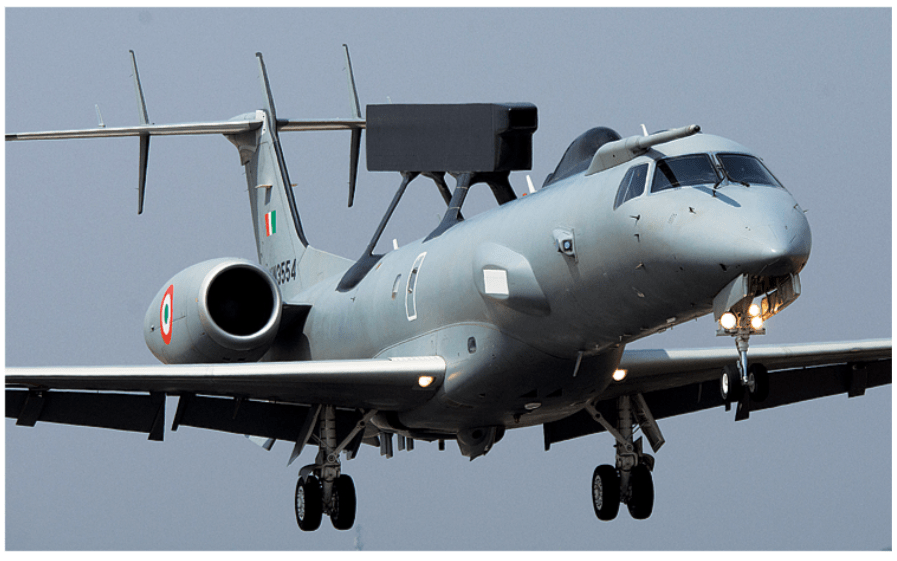India has officially approved the NETRA Mk-2 airborne early-warning and control (AEW&C) program, a next-generation “eye in the sky” intended to provide the Indian Air Force long-range, persistent surveillance over land and sea. The development will use six Airbus A321 airframes to modify the developments into airborne early-warning and control platforms, which will mount indigenous advanced sensors including a dorsal AESA (active electronically scanned array) radar and a networking mission suite for low-RCS (radar cross-section) tracking and coordination of large air operations.
What NETRA Mk-2 offers to the battleground
NETRA Mk-2 features a GaN-based AESA radar package built, according to an Indian developer, for operational detection ranges of up to 500 kilometers against conventional airborne targets, with approximately 300° to near full coverage provided by a combination of dorsal and nose-mounted arrays. Versus previous NETRA variants, Mk-2 represents a significant increase in range, aperture and processing capability, enabling earlier cueing of interceptors, extended surveillance time and improved ability to detect small, slow speed or stealth shaped aerial threats, including advanced drones.
Platform and industrial footprint
Instead of developing an entirely new airplane type, the program will upgrade pre-owned Airbus A321s – aircraft secured by the government from Air India – that will be outfitted to military specifications in Europe, and its mission systems and radars will be fitted in India. The larger A321 cabin allows for a larger, top-mounted rotodome or dorsal AESA fairing, additional operator stations, and increased on-station endurance (industry reports indicate sorties of greater than eight hours will be achievable). The conversion approach reduces lead times, while also increasing domestic industry participation: DRDO will be the systems integrator with domestic aerospace partners, and Airbus and selected international companies will assist with airframe modifications.
Timeline, cost and scale
The Cabinet Committee on Security and Defence Procurement Council approvals for the AEW&C program were formalized in 2025, with initial reports from mainstream coverage of program costing being in the low multiple thousands of crores of rupees – estimates commonly noted a budget of ₹20,000 crores (roughly US$2.3–2.5 billion depending on exchange rates) for the immediate acquisition and development tranche that aims to produce six Mk-2 aircraft. Initial deliveries and modifications/conversions for first-fight were expected to begin 2026-27, with phased induction of platform capability through the end of the decade. The program is explicitly focused on replacing and augmenting capability with the existing NETRA fleet, and to fill capability gaps with regional competitors.
Operational implication: deterrence, domain awareness and force multiplication
The introduction of six high-endurance AEW&C platforms will change India’s operational calculus in multiple ways. First, a 500-km instrumented reach means earlier detection of aircraft and cruise missiles well outside the frontline airspace, increasing commanders’ reaction time. Second, the distributive command and control enabled by the networked mission suite and datalink capacity means NETRA Mk-2 will not only detect but also vector fighters, cue ground-based air defences, and serve as airborne command nodes in operations of more complex missions. Third, the Mk-2 will be invaluable with its improved low-RCS detection and multi-sensor fusion against the anticipated proliferation of small UAS swarms and increasingly stealthy aircraft in the region. Ultimately, these characteristics demonstrate that the Mk-2 is less a platform and more a force multiplier that enhances situational awareness and integrated air defences.
Strategic context and regional dynamics
The introduction of the NETRA Mk-2 takes place at a time when we are seeing rapid advance in AEW&C modernization across the Indo-Pacific region: both competitors and neighbors are extending the sensor reach and numbers of their airborne ISR fleets. For India, AEW capability is indigenous, reducing dependence on foreign systems, ensuring control of key mission software and data flows, and providing for an exportable defence industrial base. In practical terms, the Mk-2 assists in ensuring coverage of India’s northern corridor and maritime approaches at the same time a requirement as PLA and PAF platforms expand their patrol range and observe increasing deployments of drones in theatres such as the Indian Ocean and the Himalayas.
Risks and bottlenecks
As ambitious as it may be, the program stands to reason for predictable technical and schedule risks. Development of AESA (especially GaN-based transmit/receive modules), thermal management inside a fairing, electromagnetic compatibility on a civilian-derived airframe, and systems-integration testing will all require close management. Supply-chain inflation and the logistics in ferrying aircraft to overseas modification yards may also create cost and schedule delays. Lastly, operational training in developing new tactics, techniques, and procedures for long-range AEW operations and integrating with IAF and tri-service networks is not going to be a trivial timeline item. Observers should follow trial sortie reports, radar-performance metrics in open-source reporting, and formal induction milestones through the years of 2026 – 2029.
NETRA Mk-2 represents an important advancement to India’s self-sufficient, scalable airborne surveillance architecture. If technical and schedule targets are met, the Mk-2 fleet will significantly extend India’s early warning footprint, bolster deterrence, and provide a modern airborne command node in support of today’s multi-domain threats. It will be the next 24–48 months, from formative prototype sorties, then sensor validation, to squadron fielding and incorporation. Before the promise of a 500-km “eye in the sky” will be fully found.

